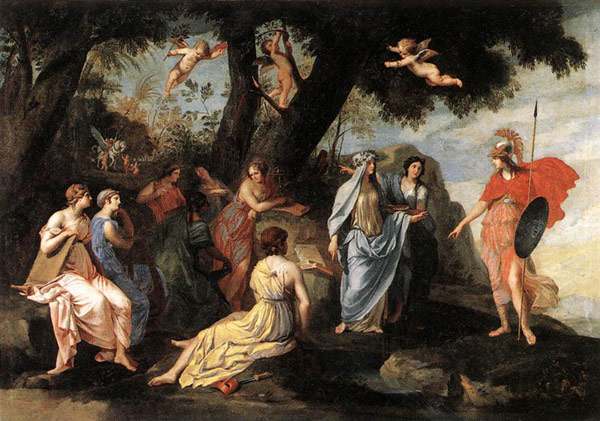The views expressed in our content reflect individual perspectives and do not represent the authoritative views of the Baha'i Faith.
Quick – what do the Muses look like?
When we try to picture the nine Muses, those legendary, inspirational daughters of Zeus and Mnemosyne, we typically think of paintings and drawings of graceful goddesses playing the harp and the lyre, or carrying the dramatic masks of Comedy and Tragedy. The Greeks often artistically portrayed the Muses as beautiful young white women, sylph-like sisters who lived in forested glades and spent their time inspiring great artists.
But wait a minute — some myths and legends depicted those Muses very differently. The Greek historian Diodoris wrote that the mythical Egyptian god Osiris first recruited the nine Muses when he passed through Ethiopia. The Muses in that version of the story were obviously African women, highly skilled in the arts of music and poetry and drama.
Whichever version of the myth you prefer, the legends of the Muses have persisted. To this day artists and musicians say they’re “courting the muse” when they dive into the creative process.
What do people mean when they use that phrase? Obviously, few still believe in the mythical nine sisters, whether black or white — so they must have some inner process in mind. No one wants to simply repeat what others have done in the past, so when we court the muse we attempt to discover a newly creative expression of our art or our craft or our work by searching for inspiration.
Artists who court the muse want to tap into that mysterious source of artistic inspiration all creative people seek. They search for a more knowing, more spiritual inner wisdom – something inside or even outside themselves that will inspire and inform their art. That inspirational, essential wisdom points the way inward, toward the emotions, the psyche, the soul. It calls upon us to cultivate a healthy relationship with the deep well of creative mystery that lies within.
Every artist and every aware human being wants to consciously create a place inside themselves that invites the spirit of inspiration to enter and stay awhile.
That’s probably why we love art. When true artists unearth their inspiration from that inner creative place they’ve managed to access and cultivate, we want to experience it. When a great musician sings the blues; when a great painter paints a masterpiece; when a great actor shows us her soul; their art allows us to briefly access those hidden, mysterious places in our own inner landscape. Their inspiration inspires us.
For years, as a journalist, I interviewed creative people – authors, musicians, artists – and asked them about their muse. I usually asked a standard question: “What inspires you?”
I got a variety of answers, some unprintable, some funny, some profound. One of the best answers came from George Harrison, after he had left the Beatles and become a solo artist. During his tour with Ravi Shankar — when he tried (frustratingly and unsuccessfully) to introduce the concept and practice of Indian spiritual music to rock fans — he told me that his musical inspiration emerged from “the meditative unwinding of my nervous system,” saying that, for him, “The corresponding experience to what winds you up comes out in your dreams.” I recently learned that same phrase wound up in a book he wrote.
I thought I understood what he meant – that slowing down the mind, using the reflective faculty we all have inside us, practicing meditation and listening to that still, small inner voice we call the muse is what really drives our creativity.
The Baha’i writings say something very similar:
Through the faculty of meditation man attains to eternal life; through it he receives the breath of the Holy Spirit — the bestowal of the Spirit is given in reflection and meditation. The spirit of man is itself informed and strengthened during meditation; through it affairs of which man knew nothing are unfolded before his view. Through it he receives Divine inspiration, through it he receives heavenly food. Meditation is the key for opening the doors of mysteries… This faculty brings forth from the invisible plane the sciences and arts. – Abdu’l-Baha, Paris Talks, p. 175.
“Through the faculty of meditation man… receives the breath of the Holy Spirit,” Abdu’l-Baha said. He also advised, during the same talk in Paris, that “while you meditate you are speaking with your own spirit. In that state of mind you put certain questions to your spirit and the spirit answers: the light breaks forth and the reality is revealed.”
For anyone who wants to access the inner source of creative inspiration, who wants the light to break forth in their spirit, the Baha’i teachings recommend beginning with a regular daily practice of silent prayer and meditation.

















Comments
Sign in or create an account
Continue with Googleor